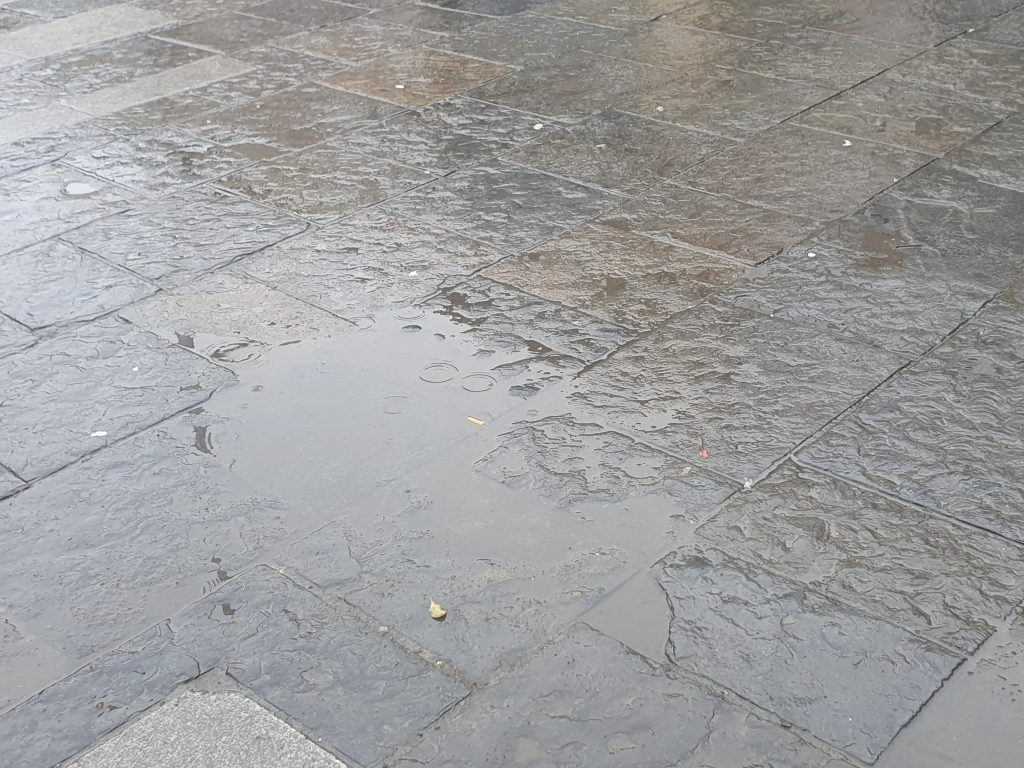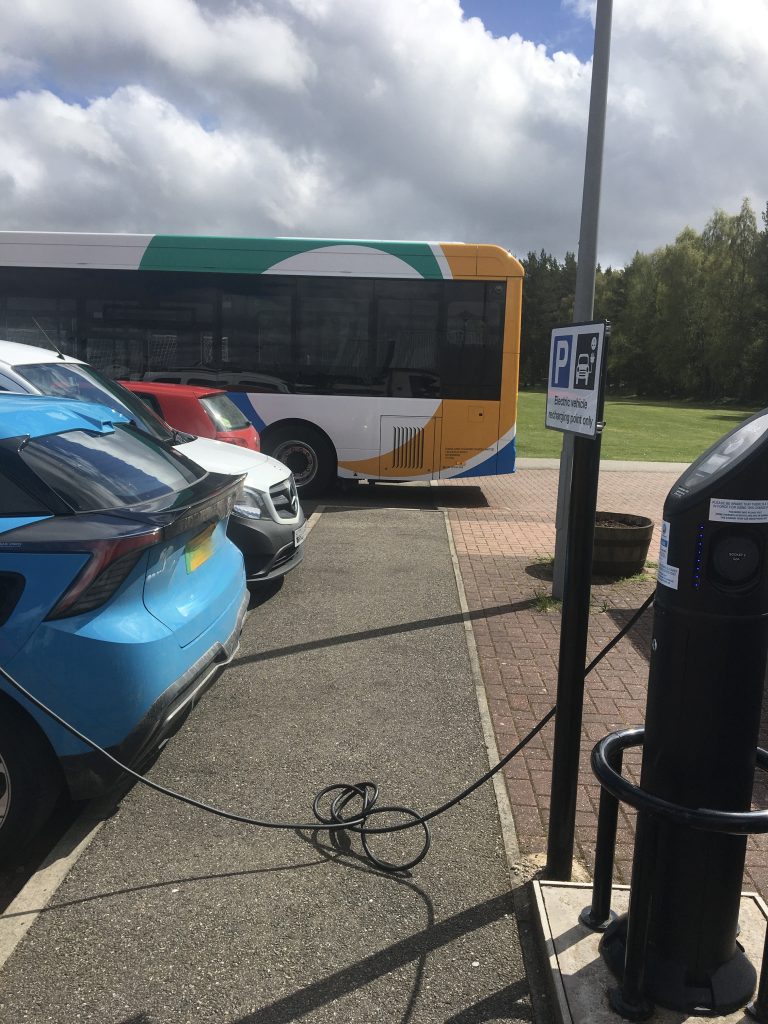Guest Blog from THINK member, Andy Hyde who reflects on his workshop for THINK members called ‘A Just Transition or Just a Transition?’
You’re unlikely to find standing water mentioned in transport accessibility strategies or decarbonisation plans. But if you’re using crutches or a wheelchair, or if your sight is impaired, or if your perception has been affected by dementia, wet surfaces and flooding can be a real challenge to navigate.

But this wasn’t another identify-the-barriers workshop. I was inviting participants to consider challenges that people encounter throughout a journey and imagine how we might link the reduction of those challenges to plans for emissions reduction. Otherwise, in the rush to decarbonise, we might fail to consider inclusion and access at the design stage. Again.
Our efforts to make travel equitable aren’t working. Flagship strategies have “failed to have an impact on transport accessibility” and any progress has been ‘slow and piecemeal‘.
This doesn’t bode well for achieving a Just Transition to low carbon travel. Committing to mobility that is both fair and low carbon means intentionally designing exclusion reduction into emissions reduction, lowering our impact on people as we lower the impact of our movement on the planet.
So, the workshop was an attempt to imagine what making that intentional link might look like.
Interestingly only one group chose a transport-related barrier to consider – getting on to the tram. The others chose a lack of toilet facilities, pavement trip hazards, pedestrian crossing safety and temporary diversions.
Our group chose poor weather and wondered about the impact of slow-draining water considering we’re expecting increased rainfall in the future. We were imagining a walking and wheeling route to the bus station that ran through a shopping centre. Who is responsible for redesigning or upgrading the drainage? And how could we ensure an understanding of how people use the space and what will make it more inclusive?
Who do we talk to? Not complain but simply ask, offer our experience to? Maybe the shopping centre owns the land. Or the council? And what’s that got to do with transport? Responsibility can be a tricky thing to establish, but by asking these questions perhaps we can start to build a picture of our journey as a system and who plays what role and where.
I had attempted to explain my thinking earlier. One of the reasons I think our current transport accessibility and inclusion efforts appear to be stuck is the lack of a systemic approach. I don’t mean ‘joined-up thinking’, but stepping back and considering the entirety of our day-to-day experience.
Even if we do manage to consider differently, we plug our results back into a system that works in silos, focusses on transport and doesn’t have the capacity to work differently.
What if we considered journeys as the system and transport as an element? An important element, but only part of the journey.
And, to avoid inclusion being increasingly eclipsed by decarbonisation, what if we didn’t apply any of what we learn back into business-as-usual?
I suggested that by using different language, redefining our approach to urgency and using our imagination we could build an alternative model to the status quo and test it.
But that was for another gathering, we were already running late.
So I asked another what if? question. Knowing that we’re in danger of redesigning for decarbonisation without taking the opportunity to redesign for inclusion, how about we link the two in some way? What if we borrowed the emissions reduction approach and applied it to improving inclusion? And what if we turned ‘inclusion’ on its head and talked about reducing exclusion?
Time is short, let’s learn from others.
If organisations already use Greenhouse Gas Protocols to help them to identify emissions they’re responsible for and create a plan to reduce them, what if we created something similar for exclusions? How about Inclusive Journey Protocols to help organisations to identify exclusions they’re responsible for, and a plan to reduce them.
Something like this:
These are my interpretations of Scope 1,2 and 3 emissions and ideas for exclusion equivalents. They’re not perfect but it’s a start.
Each group was given an organisational persona – a shopping centre, the bus station owner, a tram operator etc – and asked to choose a barrier to taking a journey across town. Did they have sole responsibility for reducing exclusion? Was it a Scope 1 Exclusion for them?
If they didn’t have sole responsibility, could they influence the reduction of the exclusion by changing their procurement process? Or could they demand better from their suppliers? If so, they’re a Scope 2 exclusion.
If something felt far away from their responsibility – a poor pavement surface across town – did they nevertheless rely on people overcoming the barrier? If so, it’s a Scope 3. What could they do to help make a change happen? This one requires digging deep but working together to reduce an exclusion in the system could be worth it – everyone would benefit. Also, whose Scope 1 is it? What’s our relationship with them? .
And so we arrived at the key part of the process. Having:
- identified a potential exclusion point somewhere in the system (somewhere along the journey)
- Named the area of responsibility (who’s scope 1,2 and 3 is it)
- Listed potential exclusion reduction actions and who could make them happen
… we were in a position to link these to emissions reduction plans.
Buying a new electric bus fleet? Here’s a list of things that need consideration to ensure that the service as well as the vehicle works for people. In what order do we need to do them to ensure that the resulting service is low carbon and inclusive?
Planning for increased rainfall? Start by understanding how the reinstated surfaces will be used by people wheeling and walking. Ask people who feel unsafe what would support them to use the space. Then consider how you will reinstate that environment after you’ve upgraded the drainage. Importantly, how will you support continued walking and wheeling while the work is carried out. Roadworks are one of the biggest barriers to getting around.
The point wasn’t to create another list of barriers. We know a lot of these already, although somehow we seem to be creating new ones all the time. I want to avoid new electric bus fleets being described as ‘a litany of missed opportunity for accessibility improvements”. I don’t want electric vehicle charging leads, designed to reduce our impact on the planet, to create a new accessibility challenge, increasing our impact on people.

At the moment we have two, separate efforts happening – reducing emissions and improving accessibility. We need to link the two somehow. We also need to recognise that our current approach to inclusion isn’t working and take a new direction.
We have a huge opportunity to do this right now as we redesign for a lower carbon world, but we have to do this with intention. A Just Transition is a fine goal but, without a system to help us get there, it’s difficult to know what the next step should be. In the meantime, the transition is already taking place.
The workshop was an attempt to put an idea out there – something (anything!) to work on, disagree with, take apart and rebuild – to start discussions about building inclusion into decarbonisation.
If you were there, thanks so much for sticking with me until the end. If you weren’t, I’ll be running a revised version very soon. Please sign up here to get details.
Thanks to the THINK network for hosting the workshop and providing time and space for discussions such as this.
You can sign up to the THINK network for free to hear about future events Become a member of THINK – The Transport and Health Integrated research NetworK (THINK) (aber.ac.uk)